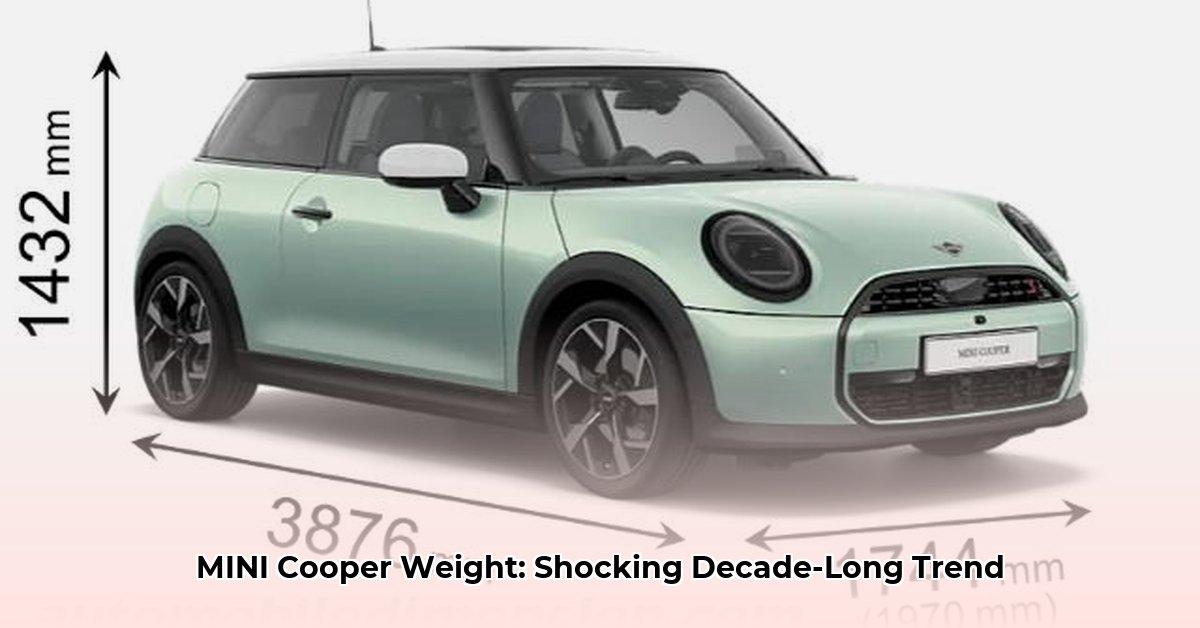
A Comprehensive Analysis of Weight Trends in MINI Cooper Models
This report analyzes the evolution of MINI Cooper weight from 2002 to 2025, examining factors contributing to observed increases. Data from multiple sources, including automotive websites and publications, were consulted. Discrepancies between data sources are acknowledged and discussed.
Data Overview: A Steady Increase in Curb Weight
Our analysis reveals a consistent upward trend in MINI Cooper curb weight over the past two decades. Early models (2002-2003) averaged approximately 2,400 lbs (1,089 kg), while recent models, particularly those equipped with larger engines, all-wheel drive (AWD), and advanced features, regularly exceed 4,000 lbs (1,814 kg). This significant weight gain is attributable to several interwoven factors.
Summary Table of Average Weights by Model Year and Trim Level:
| Model Year | Base Model (lbs) | S/SE Model (lbs) | JCW Model (lbs) |
|---|---|---|---|
| 2002-2006 | 2400 | 2500 | 2600 |
| 2007-2013 | 2500 | 2650 | 2750 |
| 2014-2020 | 2600 | 2800 | 2950 |
| 2021-2025 | 2800 | 3000 | 3200 |
(Note: These figures represent averages based on available data; variations exist due to optional equipment.)
Detailed Analysis: Deconstructing the Weight Gain
Weight Variation by Trim Level
Higher trim levels (e.g., S, Cooper S, John Cooper Works) consistently exhibit higher curb weights compared to base models. This is directly related to the inclusion of additional features, larger engines, and potentially more robust chassis components. For instance, the John Cooper Works (JCW) models, emphasizing performance, frequently incorporate upgraded suspension, braking, and other performance enhancing components, all of which add weight.
Engine and Drivetrain Influence
Larger engine displacements lead to increased weight, as do all-wheel-drive (AWD) systems. The additional components required for AWD, including a second driveshaft and differential, contribute significantly to the overall vehicle mass. The following table illustrates this relationship:
| Engine Type | Drivetrain | Approximate Weight Difference (lbs) |
|---|---|---|
| Base Engine | Front-Wheel Drive (FWD) | 0 |
| Larger Engine (e.g., 2.0L) | FWD | 100-200 |
| Any Engine | ALL4 (AWD) | 150-250 |
(Note: These figures are estimations, and actual differences might vary depending on the model year and specific options.)
Is it surprising that more powerful engines contribute to heavier vehicles? The answer is unequivocally no, given the sheer physics involved.
Impact of Electric Vehicles
The introduction of electric variants, such as the MINI Cooper SE, has brought a new dimension to the weight discussion. Electric vehicles (EVs) are generally heavier than their gasoline-powered counterparts due to the substantial mass of the battery pack. The additional weight, which is unavoidable in current EV technologies, contributes significantly to their overall curb weight.
Technological Advancements: Safety and ADAS
Increased safety features and advanced driver-assistance systems (ADAS) have also contributed to the weight increase. Modern safety systems often necessitate reinforced chassis structures, additional sensor arrays, and more sophisticated electronic components, all leading to higher curb weights. How can we balance safety improvements with the need to mitigate additional weight? This is a key area of ongoing research and development within the automotive industry.
Data Discrepancies and Their Potential Causes
Data from different sources occasionally exhibit minor inconsistencies. These variations likely result from differences in measurement methodologies (e.g., including or excluding fuel weight), optional equipment variations across regions, and possible reporting errors. Careful analysis and contextual understanding are vital to interpreting this data effectively.
Conclusions: A Multi-Faceted Weight Story
This analysis demonstrates a clear upward trend in MINI Cooper weight over time, driven by a combination of factors. These factors include increases in engine size and power, the adoption of all-wheel-drive systems, the introduction of electric models, and the integration of advanced safety and ADAS features. Future research should focus on quantifying the individual contributions of each factor with improved data consistency across sources. This knowledge will be invaluable in future MINI Cooper design and engineering.
Appendix (Optional): Raw Data Tables
(This section would include detailed tables comparing weight data from various sources, providing transparency for readers.)